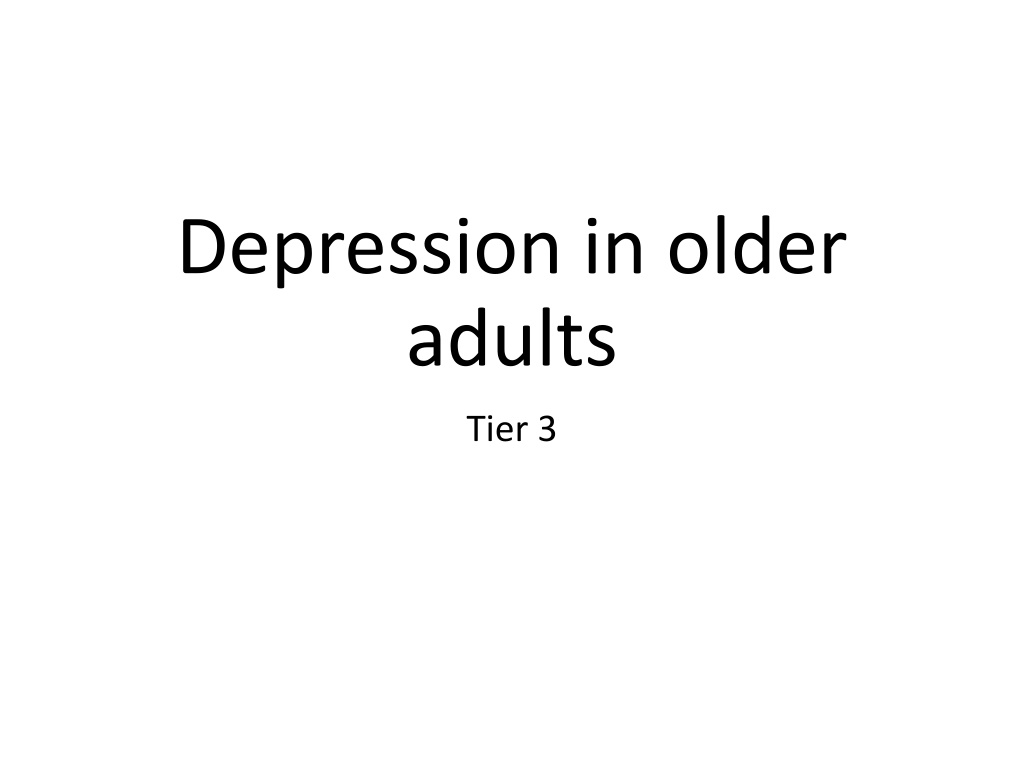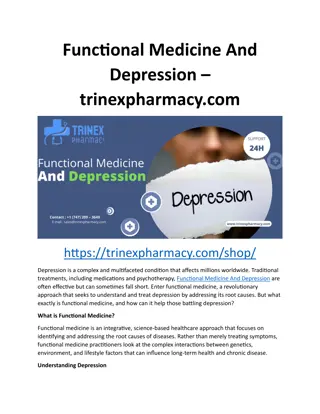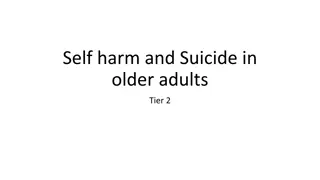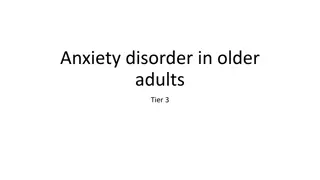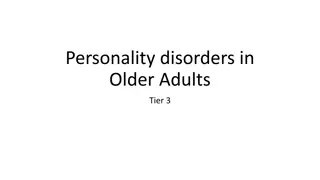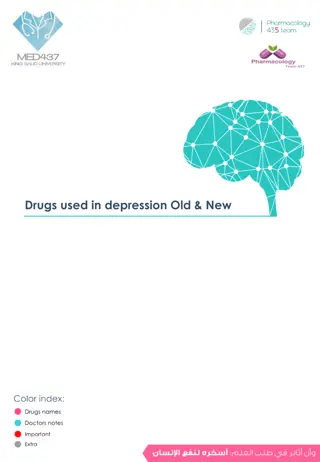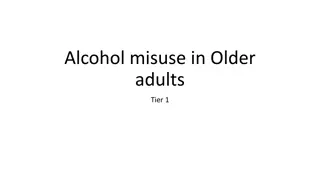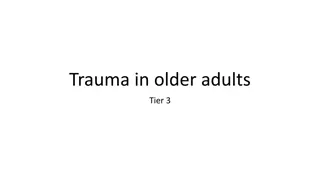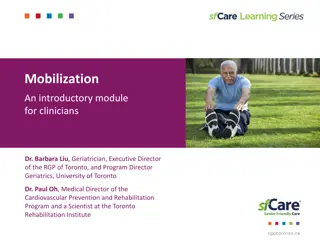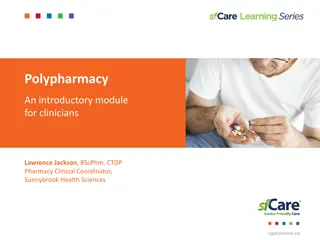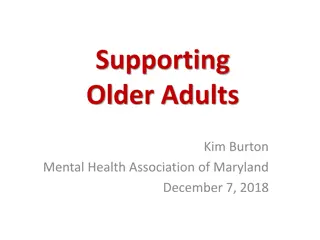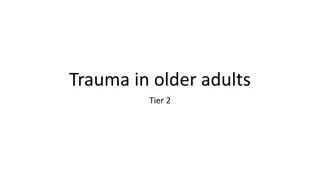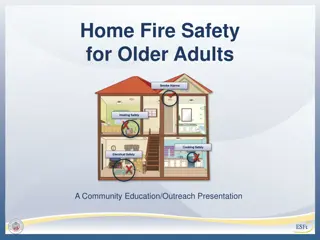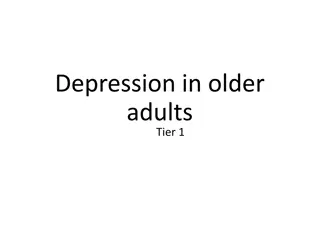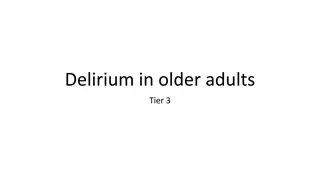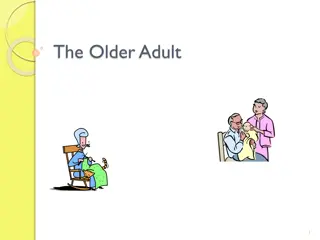Understanding Depression in Older Adults
Depression in older adults is not a normal part of aging and should not be ignored. It is characterized by a group of signs and symptoms, including depressed mood, disturbed sleep, lack of enjoyment, reduced energy levels, and thoughts of self-harm. Older adults may present with different symptoms such as anxiety, agitation, and denial of depression. The prevalence of depression in older adults is significant, with higher rates of completed suicide among this population. Risk factors include physical illness, loss of independence, loneliness, and past history of depression or abuse.
Download Presentation

Please find below an Image/Link to download the presentation.
The content on the website is provided AS IS for your information and personal use only. It may not be sold, licensed, or shared on other websites without obtaining consent from the author. Download presentation by click this link. If you encounter any issues during the download, it is possible that the publisher has removed the file from their server.
E N D
Presentation Transcript
Depression in older adults Tier 3
What is depression? A syndrome- a group of signs and symptoms that occur together and characterise depression To confirm a diagnosis: The symptoms must be on most days for at least two weeks causing significant social or functional impairment It is NOT a normal experience = NOT inevitable with ageing hence should not be ignored
Signs and Symptoms of depression Depressed mood with negative thinking Disturbed sleep - Early Morning Wakening Lack of enjoyment and interest Reduced energy levels and lack of motivation Slowness of body and mind Self-esteem and self-confidence are almost always reduced Ideas of guilt or worthlessness are often present Reduced appetite and weight loss Loss of libido Depressive delusions regarding poverty, physical illness or nihilistic in nature Thoughts of self harm and suicide
Differences in presentation Older adult may present with different symptoms to younger adult Anxiety instead of mood Agitation and restlessness including inability to keep still, constant pacing, irritability Personality changes Preoccupation with physical symptoms like faintness or dizziness, pain, weakness, constipation, tiredness. Unexplained functional decline (walking /incontinence) Memory problems ( memory impairment-self- reported) Minimisation or denial that they have depression
Prevalence of depression in older adults Prevalence in community 3-15%. GP surgeries 15-20%. Care home residents 15-20%. General / acute hospital 20% - could be as high as 40%. More common in women than men
Depression and Suicide Older adults tend to have higher rates of completed suicide. About 1in 4 older adults who attempt to end their lives complete suicide About 2/3 have depression.
Risk factors for developing Depression in older adults Physical illness: pain, Parkinson s, recent MI, strokes, TIAs, cancer Loss of sight or hearing Vascular and Lewy Body dementia Excess alcohol use Bereavement Being a carer Loss of independence/home/ social network Loneliness Past history of deprivation / abuse in their youth Past history of depression Certain prescription medications
Why is depression missed ? Older person with depression Staff Older adults may not report low mood due to stigma Staff may not consider the diagnosis and recognition is often low Older adults may not be able to express themselves Staff may believe that depression is justified/ normal Depression is expressed via bodily symptoms Staff may feel ill equipped to deal with the distress Older person may feel ashamed of feeling depressed Staff may be worried about drug side-effects Older adults may not use the term depression Staff may believe depression is untreatable
Risks Risks associated with having depression as an older adults include Increased mortality in older adults with depression especially from cardio vascular causes Self-neglect Neglect of other physical illnesses Possibility of suicide Risk of increased cognitive impairment Increased risk of institutionalisation
Assessment History and clinical picture Risk assessment around self neglect /self harm/suicidal thoughts Collateral history Rule out physical health ,medication causes Two question screening test for depression Assessment scales could be used Becks depression inventory Geriatric Depression Scale Hospital Anxiety and Depression Scale Cornell Scale
Simple questions to screen for depression Two-question screening test During the last month, have you often been bothered by feeling down, depressed or hopeless? During the last month, have you often been bothered by having little interest or pleasure in doing things? Answering yes to either of these questions is considered a positive test result, warranting further assessment.
GDS Geriatric Depression Scale Choose the best answer for how you have felt over the past week: 1. Are you basically satisfied with your life? 2. Have you dropped many of your activities and interests? 3. Do you feel that your life is empty? 4. Do you often get bored? 5. Are you in good spirits most of the time? 6. Are you afraid that something bad is going to happen to you? 7. Do you feel happy most of the time? 8. Do you often feel helpless? 9. Do you prefer to stay at home, rather than going out and doing new things? YES / NO 10. Do you feel you have more problems with memory than most? 11. Do you think it is wonderful to be alive now? 12. Do you feel pretty worthless the way you are now? 13. Do you feel full of energy? 14. Do you feel that your situation is hopeless? 15. Do you think that most people are better off than you are? YES / NO YES / NO YES / NO YES / NO YES / NO YES / NO YES / NO YES / NO YES / NO YES / NO YES / NO YES / NO YES / NO YES / NO Answers in bold indicate depression. Score 1 point for each bolded answer. A score > 5 points is suggestive of depression and warrants follow-up comprehensive assessment. A score > 10 points is almost always indicative of depression. 9/18/2024 12
Management Investigate and treat any biological factors such as some particular illnesses or medication issues Reduce any psychological factors such as difficulties with relationships Reduce any social factors, such as isolation and lack of stimulation Psychological therapies are effective so consider referral to IAPT Medications can also help Refer to Old Age Psychiatry if moderate to severe depression with no response to treatment
Medications Antidepressants: Selective Serotonin Reuptake Inhibitors (SSRIs) (most commonly used) Serotonin Serotonin and Noradrenaline Reuptake Inhibitors (SNRIs) Tricyclics Monoamine Oxidase Inhibitors (MAOI) Remember antidepressants can be effective but also carry higher risk of side effects because of multiple medical comorbidities and drug-drug interactions in cases of polypharmacy. Mood stabilisers such as Lithium
Common side effects of SSRIs Headache Feeling agitated, shaky or anxious Dizziness Blurred vision Gastro intestinal disturbances especially indigestion Insomnia / drowsiness / abnormal dreams Sexual dysfunction Also in older adults increase risk of falls and low Sodium NB Serotonin syndrome
Therapies Psychological therapy such as Supportive psychotherapy, Cognitive behavioural Therapy (CBT) , Interpersonal therapy ECT may be indicated for severe depression Treating depression is worthwhile Treatment response is usually good like younger adults
Course and Prognosis Average length of depressive disorder 6 months but 25% have episodes of more than one year. 10-20% develop chronic depression. 80% of patients with major depression will experience further episodes. On average people with major depression will experience 5 further episodes. One third of depressed patients do not complete remission between episodes.
Preventing depression Address any physical health issues early Identify sensory impairments and manage Life story reviews - find time to sit and chat Listen & share-Give genuine time, take an interest Build therapeutic relationships Encourage activities which are enjoyable Encourage exercise if possible Identify depressive symptoms early
Key points to increase detection of depression Think Depression-If you are aware of depression you will be less likely to miss it Be aware of risk factors Look for functional decline Watch for significant symptoms Ask directly about their mood Resources : Depression in Older People-animated video https://www.youtube.com/watch?v=mrqgaLnQ5zQ
Resources Depression in Older People-animated video https://www.youtube.com/watch?v=mrqgaLnQ5zQ MPC_05_06 Where There s Depression, There s Hope | Where There s Depression, There s Hope (mindedforfamilies.org.uk) This is an easy to access website for older adults and their families which has good advice about symptoms and treatment of depression in older adults
